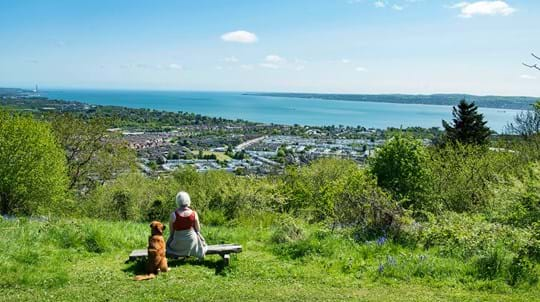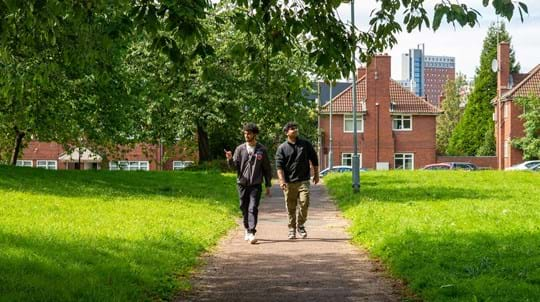
Protecting trees and woods
What urban trees do for us
They green our cities. They clean our air. They fight the effects of climate. They even increase property values. Find out what they do for people, wildlife and the economy.
More than two years in the making, take a look at how we collaborated with American Forests and the Centre for Sustainable Healthcare to bring Tree Equity Score UK to towns and cities across England, Scotland, Wales and Northern Ireland.
Video length: 00:05:18
Adam Cormack, campaigning team lead, the Woodland Trust: If you go back to the 19th century people were planting trees to kind of improve quality of life and we now live with the legacy of that. Those decisions are one of the things that are sort of driving inequalities to canopy cover.
Dr Darren Moorcroft, chief executive, the Woodland Trust: There are too many parts of the UK in the urban and our cities which don't have enough trees and we need them to have more.
Catherine Nuttgens, urban lead, the Woodland Trust: There hasn't been the focus so much on urban trees and why they're so important and I think everyone knows it but, you know it should be thought of along with lamp posts and any other urban infrastructure. They should be part of that.
Adam: I think I first learned about Tree Equity Score and within a few seconds of seeing it I knew it had potential. I'd already been talking to a number of people in the UK about this idea of trying to measure tree deprivation, and it looked like American Forests were trying to answer some of the same questions that we were in the UK. What is the situation with inequalities and tree cover? Where are trees most urgently needed in towns cities? So, it was a really natural decision then to reach out. One thing led to another and we're here two years later.
Paul Armstrong, public affairs manager, Woodland Trust Northern Ireland: So there are parts of Belfast that would have been heavily industrialised in the past. When I was showing the American Forests team around Belfast city, we stopped on a road called Lisburn Road, and if you stand on that road and you look to the right-hand side, you'll have terraced houses with no trees on that street, and you literally look across the road at the larger houses, and they're larger Victorian homes that have got the avenue, they've got the streets, they've got their gardens, but that one road kind of just shows inequity of tree distribution in one area, but that's mirrored across the city.
Adam: That idea that trees improve quality of life for people in urban areas is something we've known for a while, but Tree Equity Score will help us take it forward in a hopefully much more systematic way that will help the people who need and want trees the most.
Chris David, vice president, GIS and data science, American Forests: The biggest challenge in a partnership like this is just learning what's different in a different place. So that was challenging but also really rewarding to come to that consensus about how we're going to work on this moving forward.
Mushtaaq Ali, senior manager, GIS and data science, American Forests: England, Wales, Northern Ireland and Scotland have their own census information and also have their own indices of multiple deprivation information, so, we had to take into consideration how the data differed between those four countries to create a national dataset that was consistent, with a consistent calculation.
Adam: We've worked really intensely with the American Forests team and also our other partner the Centre for Sustainable Healthcare. We had to decide what's the data that we put into the Tree Equity Score in the UK. We ran workshops and surveys, got the views of different people and once we’d established all that, actually to build the website and the map and to test that.
Chris: To us it's so much more than a map. It's a tool to engage, it's a movement builder, it's a tool to inform and to educate and to raise funding, and so much more than that as well.
Sarah Jordan, director of green space for health, the Centre for Sustainable Healthcare: There are so many health benefits to tree equity. I don't think we're even fully aware of the full extent of the health benefits that trees can offer us, so, it has the potential to completely transform health inequalities in the UK.
Adam: So what excites me most about Tree Equity Score in the UK is the ability to illuminate disparity and to reveal inequalities in tree cover at national scales.
Catherine: What's so exciting about Tree Equity Score is that usability. With the sliding scales you can gear it to whatever funding needs you might be looking at, and I think using that as a tool that's so flexible and can be used for lots of different purposes.
Adam: 34,000 neighbourhoods where you can go and get a tree equity score, print off reports, look at all those ecosystem services, benefits of trees.
Chris: Being able to track how people are using it, staying in touch with the different local authorities here that are using Tree Equity Score, and how they're using it to increase tree equity and improve tree equity in their cities – that’s, I think, more important to us to be able to see that connection.
Paul: So we've already secured tree equity to be part of the Belfast City Council's tree strategy, and I feel that it's a really powerful tool because it provides the evidence, and the information that communities need to advocate for trees and the benefits of trees in their area.
Dr Moorcroft: I think the Tree Equity Score has a really powerful opportunity to change the trajectory of urban forestry. It will allow us to make sure that we're putting those trees in the right place, and targeting where we make a real difference.
Chris: This is a living product, so the future is bright for the global movement of Tree Equity Score. I'm feeling the excitement and I'm feeling like the true tree equity global movement is coming over the next couple of years.

Protecting trees and woods
They green our cities. They clean our air. They fight the effects of climate. They even increase property values. Find out what they do for people, wildlife and the economy.

Protecting trees and woods
Unequal distribution of trees in towns and cities is hitting those who could benefit most from urban greenery the hardest. We need tree equity.

Support us
Urban woods are the green lungs at the heart of communities, essential for the health of people and wildlife. Help give them a future.